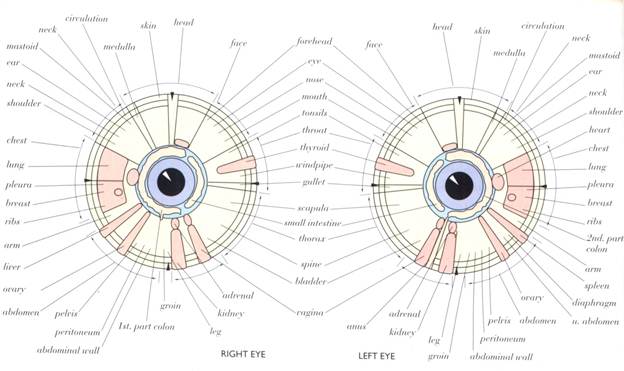You peepers aren’t just the window to your soul, they
could also be the key to solving a multitude of mysteries about your health…
Your eyes, according to iridologists
(specialists in iris analysis), could be the key to assessing your overall
health. Individual patterns and colorings make up the structure of your iris
(the colored part of the eye) and these alter in response to changes in your
body. ‘Iridologists believe that your eyes are like a road map, showing you the
direction you must travel to find health,’ says Laura Merie, naturopathic
iridologist, medical herbalist and acupuncturist at Reharmonise in London (www.reharmonise.com).

So, how does it work?
First, what color are your eyes? A person’s
overall constitution is genetically predetermined by eye color so this is an
iridologist’s first point of analysis. Blue eyes fall under the lymphatic
category (see details on each category below), brown eyes are haematogenous and
mixed eyes are biliary. The category you fall into indicates the health
problems you might be prone to.
Then it’s time to take a closer look. ‘With
a torch, a magnifier and a blown-up digital photo we correlate markings on the
eye to an iris chart,’ says Laura. In iridology every aspect of your body is
changes, that appear in this area of the iris and the marks, or color body part
or system. The left eye represents the left side of the body, the right eye
represents the right side.
‘Different marks such as streaks, white
spots, arcs and rings indicate different types of weaknesses. It could be
inflammation toxicity, blood sugar imbalances or genetic weaknesses of organs,’
says Laura. The aim is to detect health imbalances before they manifest
themselves as symptoms. Each analysis is also coupled with a detailed case
history, as well as a treatment plan.
What to look for

In the digestive zone: Toxins impact on your ability to absorb nutrients (which can lead
to excessive eating), so any changes in the color or shape of this area is key
to determining the general health of both your body and your blood stream.
In the lymph zone: Imbalances are shown as patches of color. Grey indicates an
underactive lymph system, yellow suggests a sluggish system any any brownish
markings indicate a toxic condition.
In the skin zone: Various shades of grey and brown will appear when it is sluggish or
has a build up of toxins. A dark and thick skin zone suggests that she skin is
toxic and inactive.
In the kidney zone: Spots in this area need careful evaluation as they could mean
congestion of the lymphatic system (which disposes of excess fluid and waste),
insufficient blood circulation or a build up of toxins. ‘Lacuna markings, holes
in a layer of the iris with a leaf-shaped appearance, show a weakness in the
kidney area, which may mean alcohol intake should be limited,’ says Laura.
In the lungs zone: Weaknesses in your lungs show up as a lesions, rings or spots
combined with colors ranging from white to black.
In the brain zone: This area, at the top of the iris chart, is responsible for the
pituitary glands and the cortex, as well as your vitality and energy. Any
hyperactivity shows up as whitening of the area, which could manifest itself in
the form of headaches.
In the heart zone: An interruption in the continuity of a cramp ring here can be
linked to cramp-like pains in the heart, which may indicate stress. Relax with
exercise, yoga or meditation to combat it.
Cramp rings:
Also known as stress rings, these relate to emotional issues, stiffness,
insomnia and depression, or specific organs. ‘They tend to appear in the outer
two thirds of the iris. Usually three or four are seen together, indicating
circulatory disturbances in the tissue. They can also indicate mineral
deficiencies,’ says Laura.
Cholesterol rings: A thick ring around the iris, they may indicate high cholesterol,
meaning you may need to follow a low-fat, low-salt diet.
What’s your constitution?
Laura reveals what health secrets lie
behind the color of your eyes…
Pure blue iris

The lymphatic group: Prone to experiencing allergies, eczema, hay fever, IBS and skin
problems. Regular exercise such as yoga, tai chi, qigong and swimming, as well
as practicing deep breathing, all promote good lymph flow.
Top tip:
Relax. Try to reduce stress and don’t let anxieties and worries build up. Find
something stress-relieving that works for you such as meditation or walking.
Pure brown iris

The haematogenic group: There are more tendencies towards blood sugar imbalances and poor
circulation. Cold hands and feet, stomach cramps, PMS and hormonal balances are
common.
Top tip: Try
skin brushing, saunas and regular exercise that makes you sweat. Cardiovascular
exercise so support circulation and protect against cold, such as running and
swimming, are great.
Mixed iris – green or hazel eyes

The biliary group: If you fall into this group you may experience complaints that
relate to the other two groups as well as digestive concerns, flatulence,
constipation, lethargy, migraines and skin complaints.
Top tip:
Walking after eating is good, as well as yoga postures that benefit the
digestive organs. Deep breathing is great to calm and soothe the nervous
system.